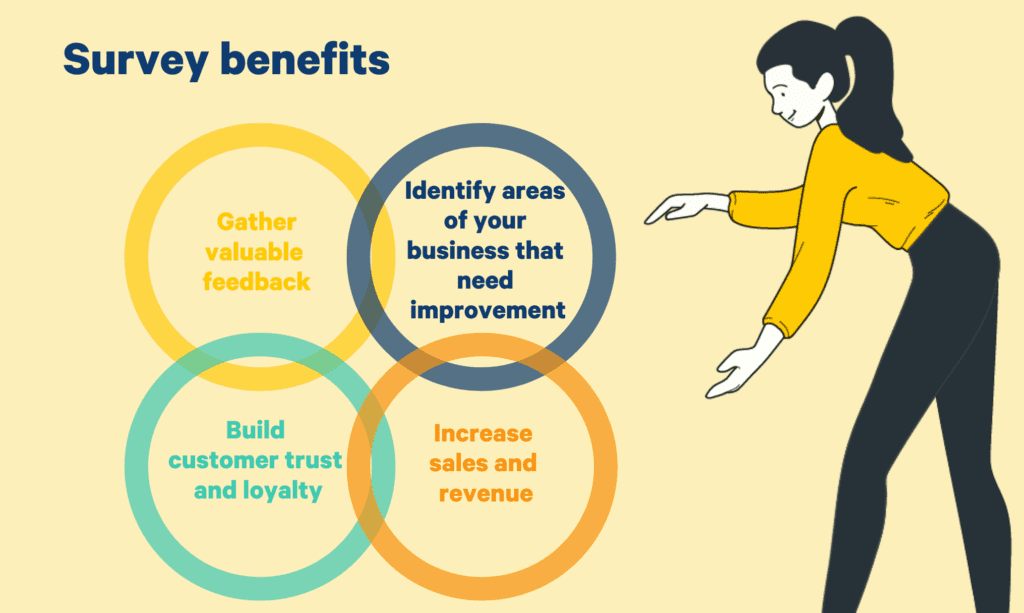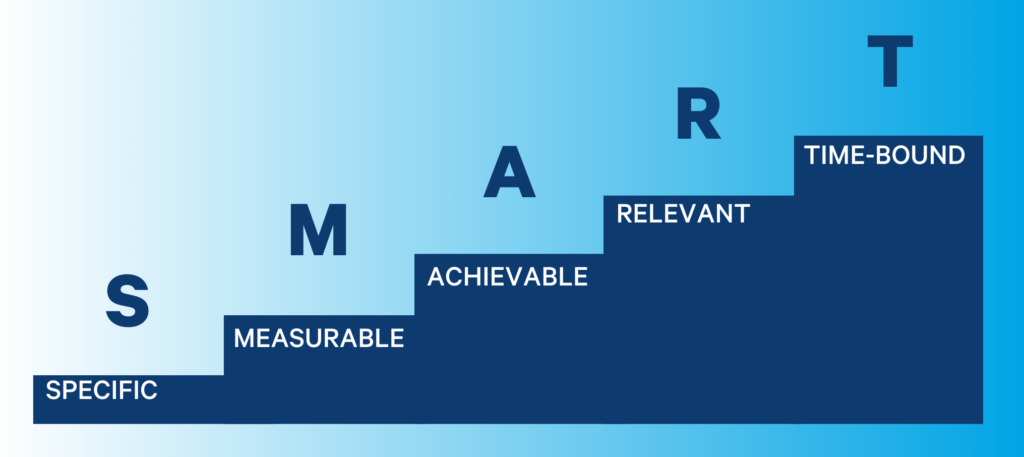Create A Customer Satisfaction Survey: 11 Things to Consider

To create a customer satisfaction survey that tells you what you have to hear, you need to prepare thoroughly.
You have to define your goals, prepare the right questions, send the survey to the right people at the right time, and analyze the results closely.
So instead of presenting questions for the customer, I will be presenting questions to YOU.
Customer satisfaction is one of the most important goals a business can have. It's also one of the most challenging things to achieve.
Before you ask your customers to spend time answering your survey, you need to make sure that you're not wasting their time.
Many people design surveys with no real goal in mind. They include irrelevant questions that don't lead to actionable insights. As a result, they end up with useless data.
To create an effective customer satisfaction survey, you need to ask yourself the right questions. In this article, we'll go over:
- The importance of customer satisfaction in 2022
- 11 questions on customer satisfaction to ask yourself
- A simple 5-step method to measure customer satisfaction
Let's form a solid foundation of the importance of customer satisfaction.
Importance of Customer Satisfaction in 2025
Many businesses still ask the question, "Why is customer satisfaction important? We deliver a quality product/service; what more do they want?"
The answer to that question is that customer satisfaction is the key to a sustainable, successful business.
A happy customer is a loyal customer.
And a loyal customer will keep coming back and making a repeat purchase. They're also the ones who will tell their friends and family about your business.
On the other hand, unhappy customers are the ones who will leave and never come back. They'll tell their friends and family about your business too – but in a negative way.
The five points below help to neatly summarize why you should pay attention to customer satisfaction:
- Leads to customer loyalty
- Saves you money
- Improves employee morale
- Boosts your reputation
- Drives innovation
Let's look into these five reasons a little closer.
1. Leads to Customer Loyalty
One of the most important reasons customer satisfaction is crucial for businesses is that it leads to loyal customers.
According to research, "customer satisfaction is a direct determining factor in customer loyalty, which, in turn, is a central determinant of customer retention" (Gerpott et al., 2001, p. 253).
Businesses that deliver a high level of customer experience have customers that return again and again. They also tend to spend more money with the company, and they're more likely to recommend the company to others.
2. Saves You Money
It costs businesses more to attract new customers than it does to keep existing ones. In fact, "acquiring a new customer can cost five times as much as retaining an existing one."
Furthermore, a "5% increase in customer retention produces more than a 25% increase in profit."
But why?
Well, returning customers are more valuable to businesses because they already know and trust the company. They much rather pay a premium for a product or service they know and like than take a chance on a new company.
3. Improves Employee Morale
You might be wondering how do satisfied customers translate to high employee morale?
The answer is simple. When employees see that their company is focused on satisfying customers' needs, the employees feel good about their job. They feel like the work they do is valuable and that their company cares about its customers.
Harvard Business School showed that having high customer happiness can boost employee satisfaction.
4. Boosts Your Reputation
A company's reputation is one of its most valuable assets. It can take years to build up a good reputation, but only a few bad experiences to lose it.
In fact, it takes 12 positive experiences to make up for one negative experience.
When customers are happy, they'll tell others about their positive experiences. Did you know that word-of-mouth is one of the most effective forms of marketing because it comes from a trusted source. It promotes not only your products and services, but also your brand reputation.
5. Drives Innovation
Innovation is a primary force that makes businesses stay ahead of the competition and keep their customers happy. Don Peppers, Founder of Peppers & Rogers Group, says:
"Customers are the link between the profit you make today and the profit you are likely to make tomorrow. The customer relationship directly connects today's profits and costs to your company's overall shareholder value."
Don Peppers, Founder, Peppers & Rogers Group
In other words, if you want to increase your profits, you need to focus on customer satisfaction.
By listening to and acting upon customer feedback, businesses can stay ahead of the competition and continue to improve their products and services. That, in turn, leads to even more satisfied customers.
So let's summarize all that we have learned in this section.
- Customer satisfaction is crucial because it leads to loyal customers
- Satisfied customers are more likely to return and spend more money
- When employees see that their company is focused on customer satisfaction, it makes them feel good about their job
- A company's reputation is impacted by the customer experience they offer.
- Innovation is essential for businesses to stay ahead of the competition and keep their customers happy
Now that we know the importance of customer satisfaction let's look at how to measure it.
11 Questions You Need to Ask Yourself When Making Customer Satisfaction Surveys
Creating customer satisfaction surveys can be a daunting task. There are many things to consider, such as the type of customer satisfaction survey questions to ask and how to word them.
Furthermore, you need to make sure that the survey is short enough that your customers will actually take it yet long enough that you'll get useful feedback.
Thus, we've compiled a list of 11 questions that you need to ask yourself when designing a customer satisfaction survey.
- What is the purpose of the survey?
- What goals are you looking to achieve?
- Who is your target audience?
- How to reach your target audience?
- What type of customer satisfaction survey questions should you include?
- What information do you need to collect?
- How will you use the results from customer satisfaction surveys?
- How will you ensure the survey is unbiased?
- How will you ensure the survey is confidential?
- What are the risks related to surveys?
- What are the benefits of conducting the survey?
Keeping these questions in mind will help you create a customer satisfaction survey template that is effective and useful for your business.
1. What Is the Purpose of the Survey?
The first question you need to ask yourself is, "what is the purpose of the survey?" By answering this question, you determine the type of customer satisfaction survey questions to ask and the information you want to collect.
By having a clear purpose, you begin to weed out the questions that are not relevant and focus on the ones that will help you achieve your goals.
Let's assume you want to know how your customers feel about your customer service. In this case, your survey might focus on questions about the quality of customer service and how happy customers are with it.
Furthermore, you don't have to include questions regarding other topics such as product quality or pricing.
2. What Goals Are You Looking to Achieve?
It may seem that the purpose and goals are the same, but there is a subtle difference. The purpose is more focused on what information you want to collect.
On the other hand, the goals are more focused on what you want to do with that information.
Furthermore, your goals should be specific, measurable, achievable, relevant, and time-bound.
For example, your goal might be to increase customer satisfaction by 10% within the next 6 months. Or target a higher net promoter score by the next quarter. To achieve these goals, you need to collect relevant data that will help you understand what changes need to be made.
3. Who Is Your Target Audience?
So imagine this, you've figured out the purpose and the goal of your survey. You've even designed the questionnaire to align with your brand identity.
However, you're not quite sure who your target audience is. This is a common mistake that many businesses make when conducting customer surveys.
Not identifying your target audience can lead to two main problems:
- You might waste time and resources surveying people who are not interested in your products or services.
- You might fail to collect enough data from a significant portion of your customer base, leading to your customers feeling unheard and unrepresented.
Furthermore, you also need to make sure you reach people at the right point in their customer journey. For example, if you want to find out how likely people are to recommend your products or service, it wouldn't make sense to survey people who just purchased your product.
They haven't had enough time to form an opinion yet. It would be more beneficial to survey people who have been using your product or service for a while.
On the other hand, if you want to find out what people think of your product before they purchase it, surveying people who are making a purchase would be more beneficial.
4. What Is the Best Way to Reach Your Target Audience?
Once you've figured out who your target audience is, the next question you need to ask yourself is, "how can I reach them?" There are a few different ways you can go about this.
You can reach out to your target audience directly through email, social media, or even in person.
You could opt for an indirect route, too, via customer research companies or online panels.
You can also use a combination of direct and indirect methods.
Trustmary allows you to reach out and import reviews from various platforms.
Failing to plan how to reach your target audience can lead to several problems.
For example, if most of your clientele are online shoppers but you only survey people in person, you're not getting an accurate representation of what your customer base thinks.
This will lead to bad decision-making and could potentially hurt your business in the long run.
5. What Type of Customer Satisfaction Survey Questions Should You Include?
This is a big one.
The type of customer satisfaction survey questions you include in your survey will determine the quality of data you collect.
The right survey questions will not only help you make informed decisions it will also make your customers feel heard.
The following table summarizes several types of survey questions you can ask and what type of information you can expect to collect from each.
| Type of Customer Satisfaction Survey Question | Information Collected |
| Open-Ended Questions | Qualitative data that can be used to generate insights |
| Close-Ended Questions | Quantitative data that can be analyzed and compared |
| Multiple Choice Questions | Quantitative data that allows more freedom in terms of answer choice |
| Likert Scale Questions | Quantitative data that can be analyzed to understand customer sentiment |
Let's say you want to ask your customers how likely they are to recommend your products or service to a friend.
One option is to use a close-ended question and ask them to rate their likelihood on a scale from 1 to 10.
This will give you quantitative data that you can analyze and compare.
Another option is to use a Likert scale question and give them a few different answer choices, such as "Very Likely," "Likely," "Unlikely," or "Very Unlikely."
This will also give you quantitative data, but it will be more limited in terms of what you can do with it.
Finally, you could use an open-ended question and ask them to explain why they feel the way they do.
This will give you qualitative data that you can use to gain insights into customer needs. You can also do a customer sentiment analysis to understand your customers feelings better.
Remember, only ask questions that provide value and not for the sake of asking them.
For example, don't ask personal demographic questions if you do not need them. That will only cause the respondent to get annoyed and may lead to them abandoning the survey entirely.
6. What Information Do You Need to Collect?
This ties in with the previous point.
Before you start creating your survey, you need to understand the type of information you want to collect.
Do you want to collect quantitative data? Qualitative data?
Both?
Are you looking to segment your target audience? Or do you want to calculate the customer effort score? If so, what type of information do you need to do that?
Once you know the type of information you want to collect, you can create your questions.
If you're not sure what type of information you need, take some time to brainstorm with your team.
What decisions do you need to make? What type of information would help you make those decisions?
7. How Will You Use the Results From Customer Satisfaction Surveys?
Imagine a scenario in which you have collected tonnes of data but have no idea what to do with it.
Not only is this a waste of time and resources, but it can also lead to bad decision-making.
That is why it's significant to have a clear plan for how you will use the survey results before you even start collecting them.
Have a clear vision of transforming raw data into actionable insights so you can make sure that your survey is focused and relevant.
8. How Will You Ensure the Survey Is Unbiased?
One of the biggest concerns for customer satisfaction survey makers is ensuring that their surveys are unbiased.
After all, the whole point of a survey is to collect objective data that can be used to make informed decisions.
However, there are a few ways that bias can creep into your survey.
For example, you may inadvertently use leading questions that push the respondent towards a particular answer. Or, you may accidentally use loaded questions that contain assumptions or value judgments.
Instead of asking, "Was the product defective when you received it?" you could ask, "How satisfied are you with the quality of the product?"
Notice the difference between the two statements.
The first statement assumes that the product was defective, while the second statement is neutral.
It's essential to be aware of the language you're using and carefully review your questions before sending them out to avoid bias in your survey.
9. How Will You Ensure the Survey Is Confidential?
Confidentiality is a big part of customer satisfaction surveys.
After all, you're asking people to give their honest opinions about your product or service. You might even be asking them to provide feedback about their experience with your company.
If they don't feel like their responses will be kept confidential, they may not provide honest answers.
To ensure confidentiality, you need to clarify to respondents that their answers will be kept anonymous.
Let the respondents know that their responses will be reported in aggregate form. No personally identifiable information will be attached to their answers.
Or, if you do plan to use their information, let them know precisely how you will do that to maintain transparency.
10. What Are the Risks Related to Surveys?
Many businesses don't think about the risks associated with their survey. But the truth is, there are a few potential risks that you need to be aware of.
For example, you could accidentally collect sensitive information that could be used to harm your respondents.
Or, you could fail to comply with data privacy laws and regulations, leading to costly fines.
To avoid these risks, it's important to have a clear understanding of the type of information you're collecting and ensure that you have the proper consent from your respondents.
11. What Are the Benefits of Conducting the Survey?
Why do you need to ask this question?
Quite simply, customer satisfaction surveys can be a lot of work.
From developing the survey to collecting and analyzing the data, a lot goes into it.
So, it's essential to make sure that you clearly understand the benefits of surveying before you start.

Some of the benefits of conducting customer satisfaction surveys include:
- Gathering valuable feedback that can be used to improve your product or service
- Identifying areas of your business that need improvement
- Building customer trust and loyalty
- Increasing sales and revenue
Bonus Question: How Long Will the Survey Take to Administer?
If you're planning on conducting the survey online, this is an important question to ask yourself.

You need to make sure that the survey is short enough that people will be willing to take it but long enough that you'll be able to collect the information you need.
A good rule is to keep the survey to a few minutes or less. This will help ensure that you get the most responses possible while still being able to collect the information you need.
In this section, we have covered 11 important questions that you need to ask yourself before conducting a customer satisfaction survey.
Asking these questions will help create effective customer satisfaction survey templates that will yield the results you're looking for.
With Trustmary’s survey maker, you can build a beautiful and efficient customer satisfaction survey template and tailor it to your needs.
Measuring Customer Satisfaction: Step-By-Step
Collecting customer feedback helps businesses track and measure customer perception.
Customer feedback surveys are one of the most widely used methods to do that.
The following is a 5 step method that businesses can use to measure customer satisfaction through surveys:
- Define what you want to measure
- Decide who you want to survey
- Choose the method of surveying
- Analyze the results
- Use the results to improve customer satisfaction
Let's briefly go through these steps.
1. Define What You Want to Measure
This might seem obvious; however, it's also the most important step. You have to be specific about what you want to know. Standard customer satisfaction metrics include net promoter score (NPS), customer effort score (CES), and CSAT.
Furthermore, instead of just wanting to know "how satisfied our customers are," you might want to know "how satisfied our customers are with our new product."
2. Decide Who You Want to Survey
The next step; decide which customers you want to include in the survey.

You can do this using various strategies, but the most important thing is to make sure that you include a representative sample of your customer base.
3. Choose the Method of Surveying
The third step is to choose the method or channel of surveying. You can choose channels such as email, phone, or in-person surveys.
It's vital to choose a method that will be convenient for your customers. Otherwise, you might not get a high response rate.
4. Analyze the Results
The fourth step is to analyze the results. This is where you'll need to take a close look at the data and see what it's telling you. You'll need to use the right formulas to determine the score for various metrics.
When analyzing the results, it's important to look at both the positive and negative feedback. This will give you a well-rounded view of customer satisfaction.
Remember to embrace constructive criticism, even if your first instinct is to defend yourself.
5. Use the Results to Improve Customer Satisfaction
The final step is to use the results to improve customer satisfaction. This is where you'll need to take the feedback and use it to make changes in your business.
For example, suppose you find that customers are unhappy with your customer service. In that case, you might need to make some changes in your customer service department.
By following these steps, you can effectively measure customer satisfaction and use the results to improve your business.
Make High Customer Satisfaction an Achievable Goal
To sum it all up, customer satisfaction is vital for a variety of reasons.
It can help you increase sales, build customer trust, and identify areas of your business that need improvement in a timely manner.
This post has highlighted a simple 5-step method for measuring customer satisfaction and 11 questions you need to ask yourself when creating a customer satisfaction survey.

As a quick recap, measure customer satisfaction by:
- Defining what you want to measure
- Deciding who you want to survey
- Choosing the method of surveying
- Analyzing the results
- Using the results to improve customer satisfaction
And when designing your customer satisfaction survey templates, keep the following questions in your mind:
- What is the purpose of the survey?
- What goals are you looking to achieve?
- Who is your target audience?
- How to reach your target audience?
- What type of customer satisfaction survey questions should you include?
- What information do you need to collect?
- How will you use the results from customer satisfaction surveys?
- How will you ensure the survey is unbiased?
- How will you ensure the survey is confidential?
- What are the risks related to surveys?
- What are the benefits of conducting the survey?
Whether you want to make a customer effort score (CES), net promoter score, or customer satisfaction survey, these questions will help you create an effective survey that promises positive results for your business.
Further Reading
- Actionable Guide to Measuring and Analyzing Customer Satisfaction in 2022
- “Trustmary helps us to manage customer satisfaction”
- Ultimate Customer Feedback Survey (with Examples!)
- Manage Customer Experience and Grow like a Unicorn
- 4 Negative Review Response Examples
FAQ
How can I calculate CSAT scores from my survey data?
The calculation of CSAT depends on the type of question and answer you use in your survey.
- If you use a "satisfied/not satisfied" question, then you can calculate CSAT by taking the percentage of respondents who answer "satisfied" and "very satisfied."
- For example, if 65 out of 130 respondents answered "satisfied" or "very satisfied," your customer satisfaction score would be 50%.
- If you use a 1 - 10 scale, then you can calculate CSAT by taking the percentage of the "sum of response score" relative to the " maximum possible score."
- For example, if the sum of all responses is 750 and the maximum possible score is 1000, then your customer satisfaction score would be 75%.
How often should I conduct customer satisfaction surveys?
Your customer satisfaction survey frequency will depend on your business goals and objectives.
If you want to use the survey results to make your business changes, you should conduct the survey more frequently. A good practice is to conduct surveys once a quarter or after significant changes in your business.
You should consider implementing customer satisfaction surveys to take place at the key customer touch points. This can easily be done directly from you CRM.
How can I improve my customer satisfaction scores?
It all starts with identifying the areas of your business that need improvement. This can be done by analyzing your customer satisfaction survey results.
Once you've identified the areas of improvement, you can start making changes in your business. These changes can be small or large, but they should be designed to improve the customer experience.
You can even ask customers what changes they would like to see in your business. This can be done through a follow-up survey or by asking customers for feedback when they contact you.
What are some common customer satisfaction survey questions?
Here are some common customer satisfaction survey questions:
- Does our product/service meet your standards?
- How likely are you to recommend our product/service to a friend or family member?
- How easy was it to use our product/service?
- How helpful were our employees?
- How satisfied are you with our pricing?
- How satisfied are you with our customer service?
- How content are you with the overall experience?
- Would you like to see any changes in our product/service?
- Is there anything else you would like to tell us about your experience?
- Would you like to be contacted by a member of our team to discuss your experience?
- Do you want to participate in a follow-up survey?
How can I increase response rates for my customer satisfaction survey?
Increasing average response rates for your customer satisfaction survey can be done in many ways.
- First, make sure that you're clear about the purpose of the survey. Let respondents know how their feedback will be used and how it will help improve your business.
- Second, make the survey as short and concise as possible. People rather get on with their lives than spend time answering questions, so keep it short and to the point.
- Third, offer an incentive for completing the survey. This could be a discount on a future purchase or entry into a contest.
- Finally, make it easy to respond to the survey. If you're using a paper survey, include a postage-paid return envelope. If you're using an online survey, make sure the link is easy to find and that the survey can be completed in a few minutes.
